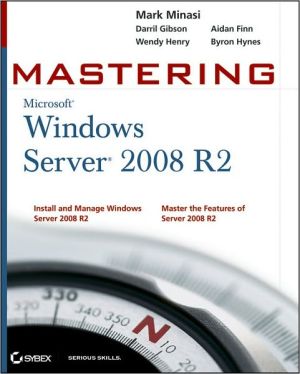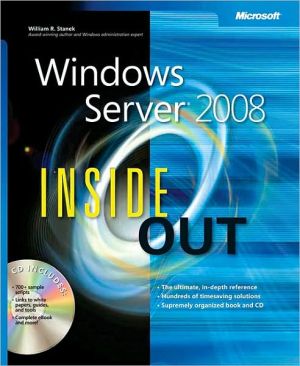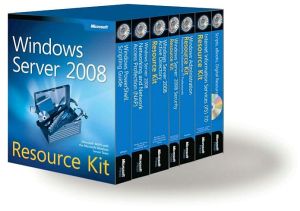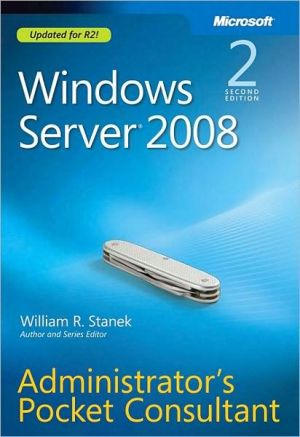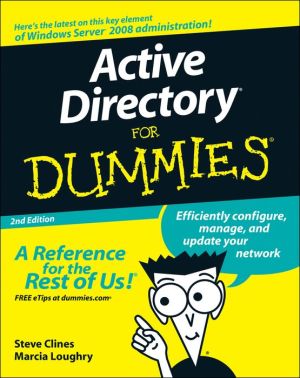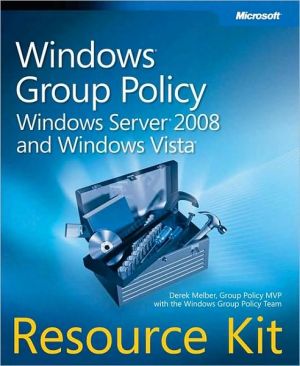Windows Server 2008 How-To
Real Solutions for Windows Server 2008 Administrators\ Need fast, reliable, easy-to-implement solutions for Microsoft Windows Server 2008? This book delivers exactly what you’re looking for. You’ll find tested, step-by-step procedures for every facet of Windows Server 2008 planning, deployment, configuration, security, and day-to-day administration. This book includes special sections looking forward to the new R2 release and fully reflects all major enhancements built into Windows Server...
Search in google:
Real Solutions for Windows Server 2008 AdministratorsNeed fast, reliable, easy-to-implement solutions for Microsoft Windows Server 2008? This book delivers exactly what you’re looking for. You’ll find tested, step-by-step procedures for every facet of Windows Server 2008 planning, deployment, configuration, security, and day-to-day administration. This book includes special sections looking forward to the new R2 release and fully reflects all major enhancements built into Windows Server 2008—including Hyper-V virtualization, Server Core, major Terminal Services improvements, and many more changes that make older administration guides obsolete. When time is of the essence, turn here first: get answers you can trust—and use—right now!Fast, Accurate, and Easy to Use! Prepare to deploy Windows Server 2008 and walk through an efficient installationAdminister Windows Server 2008 with the Microsoft Management Console (MMC), Device Manager, Task Scheduler, and Remote Desktop Use Server Manager to perform initial configuration tasks, manage settings, and administer server roles Deliver client applications more efficiently with Terminal Services Deploy Server Core to minimize attack surface and maximize security Plan, deploy, and manage Hyper-V virtualized environments that reduce costs and improve business flexibility Create, configure, secure, and manage new websites with IIS 7.x Centrally manage your users with the newest version of Active Directory Install and configure server roles such as DNS, DHCP, and file services Configure both IPv4 and IPv6 Establish efficient, practical backup and restore procedures Protect your data and infrastructure using Windows Server 2008’s multiple security features Monitor, troubleshoot, and tune server performance
Introduction: Using Windows Server 2008 How-To1How to Educate Yourself About Windows Server 2008 2How to Benefit from This Book 2How to Continue Expanding Your Knowledge 4Chapter 1 Perform the Installation5Determine Your Hardware Requirements for Windows Server 2008 6Perform Other Pre-Installation Tasks 7Check Application Compatibility 7Disconnect the UPS 8Run the Windows Memory Diagnostic Tool 8Identify Mass Storage Device Drivers 8Back Up Servers 9Disable Virus Protection Software 9Prepare Active Directory 9Decide What Edition of Windows Server 2008 to Install 10Windows Web Server 2008 11Windows Server 2008 Standard 11Windows Server 2008 Enterprise 12Windows Server 2008 Datacenter 12Windows HPC Server 2008 13Windows Server 2008 for Itanium-Based Systems 13Install Windows Server 2008 14Manual Installation 14Unattended Installation 21Chapter 2 Configure and Manage Server Core25Determine Your Need for Server Core 26Install Server Core 27Server Core Installation Options 28Extend the Evaluation 30Configure Server Core Postinstallation 30Configuration Commands 31Install Roles and Features 34Manage Server Core 36Manage Server Core with Terminal Services 36Manage with TS RemoteApp 36Manage with Windows Remote Shell 37Manage Server Core with MMC Snap-ins 37Incorporate Server Core Changes inWindows Server 2008 R2 39Make Progress in Server Core Administration 40Chapter 3 Work with Server Manager41Use Initial Configuration Tasks 42Navigate Settings with Server Manager 43Perform Role and Feature Management 45Know Your Server Roles 45Know Your Server Features 49Install Roles 52Install Features 55Use the Command-Line Server Manager (ServerManagerCmd.exe) 56Know What R2 Will Bring to Server Manager 58Chapter 4 Manage Windows Server 200859Use the Microsoft Management Console (MMC) 60Work with Preconfigured MMCs 64Server Manager 64Computer Manager 65Utilize Device Manager 66Work with the Task Scheduler 67Manage Windows Server 2008 Using Remote Desktop 72Configure Backups and Perform Restores 76Chapter 5 Install and Configure Specific Server Roles81Install and Configure the DNS Server Role 82Create and Configure DNS Lookup Zones 83Manage a DNS Server 86Manage a DNS Zone 87Install and Configure the DHCP Server Role 90Configure Additional Settings in DHCP 93Configure IPv4 and IPv6 Settings 93Configuring Scope Options 94Configure IPv6 in Windows Server 2008 96Make Progress with IPv6 98Install and Configure the File Services Role 98Work with Share and Storage Management 101Work with the File Server Resource Manager 102Work with DFS Management 103Understand the Improvement Windows Server 2008 R2 Brings to Server Roles 105Chapter 6 Work with IIS 7.0107Install the Web Server Role 108Create, Configure, and Manage New Websites 114Secure Websites 118IP and Domain Restrictions 119Restrictive Authentication 119HTTP Request Filtering 119Restrict Directory Browsing 120Delegate Rights Assignments 121Use the Command Line with IIS 7.0 124Add a Website Using appcmd.exe 126Configure a Website Using appcmd.exe 127Delete a Website Using appcmd.exe 127Back Up Your Configuration 127View Available Configuration Backups 127Restore Configuration Backups 127Improve IIS 7.0 Performance 128Output Caching 128Compression 129Logging Frequency 130Windows Server Resource Manager (WSRM) 130See What’s New in Windows Server 2008 R2 131Chapter 7 Implement and Utilize Hyper-V133Install the Hyper-V Role 134Install Hyper-V on a Full Installation of Windows Server 2008 135Install Hyper-V on Server Core 137Manage Hyper-V Remotely 137Create Virtual Hard Drives and Machines 138Virtual Hard Drives 139Create Virtual Machines 141Work with the Virtual Machine Connection Tool 143Install Integration Services 145Monitor Hyper-V Performance 146Utilize System Center VMM 147Prepare for New Features to Hyper-V in Windows Server 2008 R2 149Chapter 8 Install and Configure Terminal Services151Determine Which Terminal Services Roles to Install 152Install Terminal Services 154Install the Terminal Server Role Service 154Install the TS Licensing Role Service 156Install the TS Session Broker Role Service 157Install the TS Gateway Role Service 157Install the TS Web Access Role Service 160Configure Terminal Services 160Configure the TS RemoteApp Manager 161Configure the TS Gateway Manager 163Configure a Load-Balanced Farm with TS Session Broker 166Configure Terminal Services 167Manage Terminal Services 169Add RemoteApp Programs 170Monitor Terminal Services 173Get More from Terminal Services in Windows Server 2008 R2 175Chapter 9 Understand and Manage Active Directory179Understand the Functionality of Active Directory 180Visualize the Physical and Logical Sides of Active Directory 180Utilize Domain Controllers Appropriately 182Read-Only Domain Controllers (RODCs) 183Promote Servers as Domain Controllers 184Install the First DC of the Forest 184Setting Up Additional DCs 187Prepare an Existing Domain Schema 191Create Active Directory Objects 192Design and Create an OU Structure 192Create Computer Objects 193Create User Objects 195Work with Site and Domain Consoles 198Active Directory Sites and Services 198Active Directory Domains and Trusts 202Utilize Other Active Directory Services 204Improve Active Directory with Windows Server 2008 R2 205Chapter 10 Utilize Group Policy207Grasp the Structure of Group Policy 208Group Policy Objects 208The Group Policy Central Store 208The Application Order of Group Policy 209Use Starter GPOs 210Create and Apply Group Policies 211Access Group Policy Settings 211The Group Policy Management Editor 212Change an Existing GPO 216Create a New GPO 216Apply a GPO 218Create and Apply a GPO 218Configure Group Policy Application Settings 218Raise or Lower the Link Order 219Disable a Policy 220Disable Half a Policy 220Delete a Link or a Policy 221Block Inheritance 221Enforce a Policy 221Filter GPO Application 222Work with Group Policy Modeling and Results 224The Group Policy Modeling Wizard 224The Group Policy Results Wizard 225Prepare for Windows Server 2008 R2 Enhancements to Group Policy 226Chapter 11 Configure Security229Understand Security Improvements in Windows Server 2008 230Built-in Security Features 230User Account Control (UAC) 233Additional Security Components 234Configure Windows Firewall with Advanced Security 235Create Inbound and Outbound Rules 237Create Connection Security Rules 239Monitor Windows Firewall and Advanced Security 241Configure NAP 242Install the Network Policy Server 242Configure NAP Health Policies 243Configure System Health Validator and Remediation Server Groups 245Configure Policy Properties 247Plan for Security Changes and Additions in Windows Server 2008 R2 248Changes to Security 248Chapter 12 Monitor Performance and Troubleshoot251Monitor Performance in Windows Server 2008 252Use the Performance Monitor and the Reliability Monitor 253Create a Data Collector Set 257Configure Data Collector Sets 259Use Reliability Reports 260Troubleshoot Windows Server 2008 262Troubleshoot Using the Event Viewer 262Manage Event Viewer 263Create a New Subscription 265Troubleshoot Using Command-Line Tools 266Use the Problem Reports and Solutions 266Monitor Performance and Troubleshoot in Windows Server 2008 R2 269Index 271

